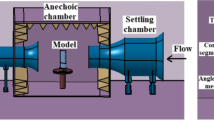Abstract
For the problem that the flow separation on the flap lowers the aerodynamic performance of high lift system, an investigation was carried out on using micro vortex generators (VGs) to control the separation on flap of the swept constant chord half-model (SCCH) high-lift configuration, at a small to medium angle of attack, by experimental and numerical methods. The basic flow characteristics of SCCH landing configuration were analyzed by using numerical method to provide required information for the design of micro VGs. Then, by keeping the cruise configuration intact, the preliminary design procedure and design methods of micro VGs were established. In addition, the micro VGs were designed. The effects of VG’s arrangement and geometric parameters, such as the arrangement mode, chordwise position, arrangement angle, height and spanwise distance, on controlling efficiency were investigated by using numerical method. Then the parameters of preliminary VGs were adjusted as the basis configuration for wind tunnel test. The experiments were accomplished in NH-2 wind tunnel for validating the numerical method, as well as obtaining the design principles and methods of micro VGs. The parameters of VGs were also optimized based on the experiments. The experimental results showed that the numerical design method can serve as an efficient and accurate design tool. The lift and drag were increased by 10% and 14%, respectively in landing state, which satisfied the requirements for landing. Finally, it was concluded that the established design principles and methods for micro VGs in this investigation can be used in engineering application.
Similar content being viewed by others
References
Gamer P L, Meredith P T, Stoner R C. Areas for future CFD development as illustrated by transport aircraft applications. AIAA Paper 1991-1527, 1991
David S. Passive flow control on civil aircraft flaps using sub-boundary layer vortex generators. In: KATnet II Separation Control Workshop. Toulouse: Airbus, 2008
John C L. Review of research on low-profile vortex generators to control boundary-layer separation. Prog Aerosp Sci, 2002, 38: 389–420
Yang K, Zhang L, Xu J Z. Simulation of aerodynamic performance affected by vortex generators on blunt trailing-edge airfoils. Sci China Tech Sci, 2010, 53(1): 1–7
Meunier M, Brunet V. High-lift devices performance enhancement using mechanical and air-jet vortex generators. J Aircraf, 2008, 45(6): 2049–2061
Barrett R, Farokhi S. On the aerodynamics and performance of active vortex generators. AIAA Paper 1993-3447, 1993
Vos J B, Rizzi A, Darracq D, et al. Navier-stokes solvers in european aircraft design. Prog Aerosp Sci, 2002, 38: 601–697
Huang J B, Xiao Z X, Fu S, et al. Study of control effects of vortex generators on a supercritical wing. Sci China Tech Sci, 2010, 53(8): 2038–2048
Hwang S J, Ilwoo L. Lift dump on a fighter-type wing at approach condition. AIAA Paper 2004-726, 2004
Stanewsky E, Rosemann H. Active flow control applied to military and civil aircraft. In: Active Control Technology for Enhanced Performance Operational Capabilities of Military Aircraft, Land Vehicles and Sea Vehicles. Braunschweig: RTO, 2000, K1-1-K1-16
Calarese W, Crisler W P, Gustafson G L. After-body drag reduction by vortex generators. AIAA Paper 1985-0354, 1985
Liipfert E, Riffelmann K J, Price H. Experimental analysis of overall thermal properties of parabolic trough receivers. J Sol Energ-T ASME, 2008, 130(2): 021007
Zhang J, Zhang B Q, Yan W C, et al. Investigation of boundary layer separation control for supercritical airfoil using micro vortex generator (in Chinese). J Exp Fluid Mech, 2005, 19(3): 58–61
Godard G, Stanislas M. Control of a decelerating boundary layer. Part 1: Optimization of passive vortex generators. Prog Aerosp Sci, 2006, 10: 181–191
Brunet V, Francois C, Garnier E, et al. Experimental and numerical investigations of vortex generators effects. AIAA Paper 2006-3027, 2006
Steven M K, Michael P, John C L. A flow physics study of vortex generators on a multi-element airfoil. AIAA Paper 1996-0548, 1996
John C L. Control of turbulent boundary layer separation using micro vortex generators. AIAA Paper 1999-3404, 1999
Keith S B. Passive flow control on civil aircraft flaps using sub-boundary layer vortex generators in the AWIATOR programme. AIAA Paper 2006-2858, 2006
Christopher L R, Susan X Y. Prediction of high lift: Review of present CFD capability. Prog Aerosp Sci, 2002, 38: 145–180
Tinoco E N, Bogue D R, Kao T J, et al. Progress toward CFD for full flight envelope. Aeron J, 2005, 10: 451–460
Chu H B, Chen Y C, Zhang B Q, et al. Investigation of numerical simulation technique for micro vortex generators applied to high lift system (in Chinese). Acta Aeron Astron Sinica, 2012, 33(1): 11–21
Bohbot J, Grondin G., Darracq D. A parallel multigrid conservative patched/sliding mesh algorithm for turbulent flow computation of 3d complex aircraft configurations. AIAA Paper 2001-1006, 2001
Shi Y B, Wang H J, Li J. Exploring a feasible method of CFD simulation of high-lift aircraft configuration using patched grid generation method and multi-grid technique (in Chinese). J Northwest Polytech Univ, 2010, 28(1): 143–146
Sang W M, Li F W. Adaptive cartesian grid method in numerical simulation of flow field about civil-plane high-lift system (in Chinese). Acta Aerodynamica Sinica, 2004, 22(4): 427–432
Chu H B, Zhang B Q, Chen Y C, et al. Controlling flow separation of high lift transport aircraft with micro vortex generators (in Chinese). J Northwest Polytech Univ, 2011, 29(5): 799–805
Author information
Authors and Affiliations
Corresponding author
Rights and permissions
About this article
Cite this article
Chu, H., Zhang, B., Chen, Y. et al. Investigation of micro vortex generators on controlling flow separation over SCCH high-lift configuration. Sci. China Technol. Sci. 55, 1943–1953 (2012). https://doi.org/10.1007/s11431-012-4855-0
Received:
Accepted:
Published:
Issue Date:
DOI: https://doi.org/10.1007/s11431-012-4855-0




